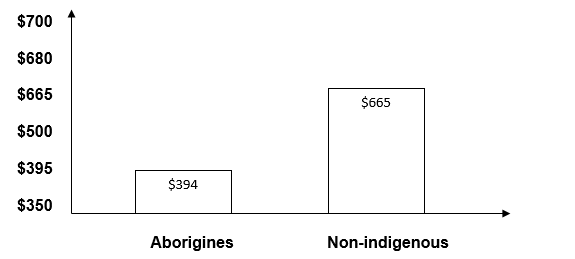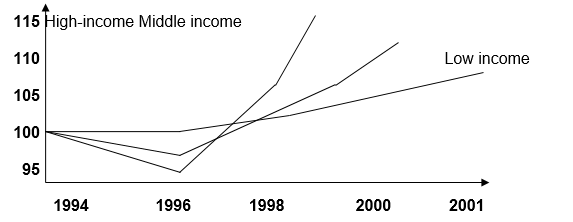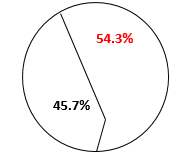Introduction
Inequality can be considered as one of the major characteristics of the development of human society. Throughout the whole history of mankind, people have tried to fight inequality, and this trying was expressed in political movements, social protest actions, and even military conflicts. However, even the most reputable scholars, who deal with purely economic sides of an inequality, are seemingly unable to find the answers to the questions about the nature of inequality and the means to overcome it.
The theories developed by scholars like Frank (2009, p. 98), Mankiw (2009, p. 440), Rowls (2005, p. 72) focus on income distribution as the major market of the inequality that characterizes the development of humanity. The Australian society and the position of indigenous people, or Aborigines, in it, is one of the most vivid examples of the unequal income distribution and the effects it has on all spheres of lives of the discriminated groups of people. The unequal income distribution manifests itself with the special emphasis in such areas as cultural identity, access to education, and proper health care, which are all far from the best standards for the Australian aborigines in the country’s rural regions.
Economic Theory of Income Distribution
General Notions
Thus, to gain a better understanding of the economic theory of income distribution in general and see its specific implications for the Australian rural areas’ aborigines, it is necessary to consider the ideas of the major reputable scholars in this sphere of knowledge. Needless to say, several scholars including Bertola (2006, p. 51), Bronfenbrenner (2006, pp. 489 – 490), and Pritchard (2000, p. 212), try to explain the inequality of income distribution, which is seemingly perceived as the norm in the modern human society, by such factors as the natural development of things where some people have means and power to regulate the lives of other people.
At the same time, the latter group of human beings is subject to decisions of the former group in all aspects, including the levels of their incomes and how these incomes are distributed among them (Bertola, 2006, pp. 51 – 52). In this respect, the ideas by Mankiw (2009) are of special interest because they explain the unequal income distribution from a purely scholarly viewpoint, in which special importance is attributed to in-kind transfers, economic life cycle, and transitory and permanent incomes every person has (Mankiw, 2009, pp. 439 – 440).
Implications for Australian Aborigines
Whichever theoretical approach is applicable for the topic considered in this paper, the specific situation in which the Australian aborigines living in rural areas find themselves is rather controversial. The pillars of this controversy are the drastic differences between incomes of indigenous and non-indigenous people residing in similar areas, as well as health care and education standards for these people (NATSINWP, 2000, p. 43; Australian Bureau of Statistics, 2005, p. 286). The specific evidence of the above claims can be found in the data by the Australian Bureau of Statistics (2005) as well as the works by Franklin (2010, p. 24) and Francis (2005, pp. 29 – 30).
Thus, the proportion of the mean household income for an indigenous family and a non-indigenous one illustrates the fact that the income distribution is twice as high for non-indigenous people than for the Australian rural aborigines (see Chart 1). At the same time, 52% of aborigines receive state support in the form of welfare as compared to only 27% of non-indigenous people, but still, the income of the latter is almost twice as high as of the aborigines (Franklin, 2010, p. 24):

Such a comparative picture of income levels for aborigines in rural areas and non-indigenous people in the same locations is rather controversial in the light of the average Australian household income dynamics as presented by the Australian Bureau of Statistics (2005):

Issues of Australian Aborigines
Tribal and Cultural Controversy
Influence of Elderly People
So, the theoretical framework for the income distribution issue is presented and its implications for the Australian aborigines are observed. Now, it is possible to inquire about the deeper roots and long-term effects of the major problem of the current paper, i. e. the inadequate income distribution for Australian aborigines living in rural areas. One of the basic characteristic features of the aborigines in Australia is the great power of customs and traditions in their daily lives.
Pritchard (2000, p. 118) and Rowls (2005, p. 218) considers the influence of elderly people to be one of the main factors that allow the aborigines to preserve their identity in the permanently changing and globalizing world. Thus, the influence of elderly people is one of the few aspects of the aborigines’ social life that allow seeing improvements in the area of income distribution in the future. But still, numerous factors serve as obstacles for those potential improvements and positive developments.
Alcohol Abuse
One of such daunting issues for the Australian aborigines that inhabit the rural areas of Australia is alcohol abuse and the associated social and health care issues (NATSINWP, 2000, pp. 25 – 26). According to the data by National Aboriginal and Torres Strait Islander Nutrition Working Party (2000), abuse of substances like alcohol and tobacco often becomes the major reason for the improper and inadequate distribution of household income and other social benefits in the rural aboriginal communities in Australia (p. 12).
The point here is that female representatives of the aboriginal communities preferably spend the bulk of their incomes on food, clothes, and other necessary things in everyday life. At the same time, male aborigines are reported to have tobacco and alcohol addictions that in most cases hinder their income distribution at the proper rate. Since males head the families in rural aboriginal communities, alcohol and tobacco abuse become major determinants of the improper income distribution, for which none of the governmental agencies can be blamed and to which none of the above discussed economic theories can be applied (NATSINWP, 2000, pp. 25 – 26; Bronfenbrenner, 2006, p. 117; Mankiw, 2008, p. 213).
Unemployment
Another serious issue, although often viewed as an opportunity (NATSINWP, 2000, p. 10), is the huge rate of unemployment observed in the remote rural areas where the majority of the population consists of the aborigines. The major factors that condition the high unemployment are simple and plane: lack of jobs for the rural areas’ inhabitants to take, the reluctance of governmental agencies to work on the creation of those jobs, lack of educational qualifications of the local inhabitants to take jobs available in the rural or urban areas (Francis, 2005, p. 32).
In this situation, the argument by the NATSINWP (2000) presents a point of special interest and it defends the point that unemployment is beneficial for aborigines who, not having qualifications or educational opportunities, retrieve the bulk of the annual incomes from governmental help programs like welfare, unemployment payments, etc (NATSINWP, 2000, p. 10). Accordingly, this situation fits into Mankiw’s (2008, p. 439) idea of Transitory vs Permanent income as aborigines prefer having permanent income from the governmental payments to having transitory incomes from seasonal jobs. Such an approach allows aborigines in rural areas to maintain their stable, although rather low, the standard of living, but deprives them of any potential for improvement.
Lack of Access to Education
Education, or to be more specific its absence, constitutes another serious issue for the development of rural aboriginal communities and income distribution in them. According to the Australian Bureau of Statistics (2005) and NATSINWP (2000), over 80% of aborigines in rural areas have no access to education, and this percentage increases together with the remoteness of the rural location from an administrative center in the country (NATSINWP, 2000, p. 21).
Drawing from this, the low educational levels can explain the inadequate income distribution among indigenous and non-indigenous people in rural areas if viewed through the Economic Life Cycle theory by Mankiw (2008, p. 439). The essence of the theory lies in the assumption that the income levels of a human being rise to 50 years of age when the person gets educated and acquires professional; experience; after retirement at 50+ years of age, the income levels start dropping (Mankiw, 2008, p. 439). In this context, Australian rural aborigines do not go further than the first stage when incomes are minimal because they do not have educational access and hence they cannot progress in gaining professional experience.
Health Care
Poor Health Care Facilities
However, if the educational and employment factors that condition the inadequate income distribution can be explained through economic theories, the poor state of development of the health care sphere cannot; it can only be viewed as a logical, although not fair, a consequence of the low living standards of rural aboriginal communities (Pritchard, 2000, p. 187).
The major health care problems for aborigines in rural areas of Australia concern the shortage of qualified health care personnel willing to relocate to rural regions, the inability of the government to motivate health care workers for the development of rural facilities, and the lack of funds for aborigines to pay for the health care services (Francis, 2005, pp. 32 – 33). Moreover, similarly to the unemployment and education levels, the standards of health care become poorer as the residential locations become more remote from urban centers (NATSINWP, 2000, p. 22). The explanation of such a situation requires no theories of income distribution; it is enough to calculate the income that health care professionals would retrieve in urban areas and compare them to the potential rural incomes multiplied by the low living standards in the majority of rural settlements.
Inadequate Health Care for Aborigines
At the same time, the seemingly obvious arguments that explain the poor state of health care in rural areas do not explain the reasons why rural inhabitants, predominantly aborigines, should be exposed to diseases and hazards of the wildlife without the proper protection. The issue of income distribution comes into play again if one tries to compare the health care services that indigenous and non-indigenous people can afford:


Thus, the charts above reveal the drastic difference in the percentage of aborigines and non-indigenous people that cannot afford such a basic health care service as the use of an emergency in a respective case. The figures in red reflect the percentages of those people, and thus it is obvious that only 13.6% of non-indigenous people do not have the proper health care, while among the aborigines this proportion amounts to more than a half of all population, 54.3%. None of the considered economic theories of the income distribution can properly explain the gap of 41.3% in health care availability and the government should take steps to improve the situation.
Conclusions
So, the above-presented consideration of income distribution among the Australian aborigines living in rural areas reveals that some aspects of the inequality in this distribution can be explained by the economic theories developed by Mankiw (2008), Fank (2009), etc. However, poor health care, lack of educational opportunities, and associated unemployment can hardly be viewed through the mere prism of economic theory. Accordingly, serious governmental steps are required to bring the living standards of aborigines in Australian rural areas at least closer to the standards for non-indigenous people.
Reference List
Australian Bureau of Statistics. (2005) Yearbook, Australia. Aust. Bureau of Statistics.
Bertola, J. (2006) Income distribution in macroeconomic models. Princeton University Press.
Bronfenbrenner, M. (2006) Income Distribution Theory. Transaction Publishers.
Fank, R. (2009) Microeconomics and Behavior. McGraw-Hill.
Francis, K. (2005) Health and health practice in rural Australia: where are we, where to from here? Online Journal of Rural Nursing and Health Care, 5(1), 28 – 36.
Franklin, N. (2010) Indigenous Health and Welfare in Central Australia. Charles Darwin University.
Mankiw, G. (2008) Principles of Economics. Cengage Learning.
NATSINWP. (2000) National Aboriginal and Torres Strait Islander Nutrition Strategy and Action Plan 2000 – 2010. National Aboriginal and Torres Strait Islander Nutrition Working Party.
Pritchard, B. (2000) Land of discontent: the dynamics of change in rural and regional Australia. UNSW Press.
Rowls, J. (2005) A theory of justice. Harvard University Press.